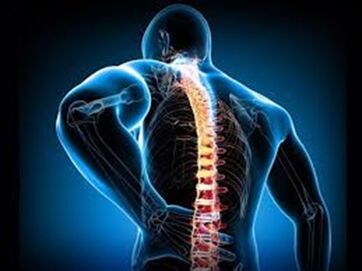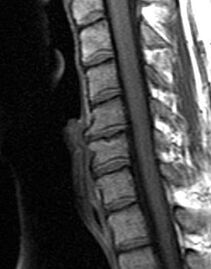Degenerative disc disease of the thorax (osteochondrosis) is relatively rare compared to other vertebrae. This is because the rib cage stabilizes the thoracic vertebrae, restricting movement and injury, as it does in the rest of the spine. If osteochondrosis develops in the thoracic spine, then its development is most often associated with trauma.

Degeneration, destruction and inflammation in the disc area can cause a number of symptoms depending on the severity of the problem. Disc pathology can cause symptoms such as decreased lumbar mobility, back pain that can spread to the intercostal space, numbness, tingling, muscle spasms, or certain combinations of these symptoms. The most common manifestations of osteochondrosis in the thoracic region occur at the level of T8-T12. As a rule, the manifestations of osteochondrosis in the thoracic region are: protrusion, disc extrusion, herniated disc with sequestration, spondylolisthesis.
Treatment of thoracic osteochondrosis is most conservative, but surgical treatment is possible when there are complications such as spinal cord compression.
Osteochondrosis (degenerative disc disease) is not actually a disease, but a term used to describe progressive changes in the discs associated with the development of secondary symptoms after progressive erosion and disc degeneration. Disc degeneration is a normal evolutionary process, but in certain situations the degeneration process can be accelerated, such as trauma, overuse, and musculoskeletal disorders such as scoliosis. Disc degeneration is not a problem in itself, but the conditions associated with it can lead to the development of advanced symptoms.
Stages of disc degeneration
The development of disc degeneration can be classified into the following stages:
Dysfunction
- Tears are possible in the area of the annulus fibrosus with irritation of the facet joints at the appropriate level of the tenth.
- Loss of joint mobility, local low back pain, muscle spasm, and restrictions on trunk mobility, especially stretching.
Instability
- Fluid loss by a disc with dehydration and a decrease in disc height. Weakness of facet joints and capsules may develop, leading to instability.
- The patient will experience pain of a shooting nature, spinal straightening, and a sharp decrease in the level of movement in the trunk.
Re-stabilization
- The human body reacts to instability by the formation of additional bone in the form of osteophytes, which to some extent helps to stabilize the spine. However, excess bone formation can lead to spinal stenosis.
- Back pain generally decreases, but remains less intense. Some people may develop stenosis-like symptoms.
Reasons
- Involuntary changes in the body are the most common cause of disc degeneration. As the body ages, the discs gradually lose fluid and become dehydrated. The discs begin to shrink and lose height, impairing their ability to absorb shock and stress.
- The fibrous structures of the outer ring of the disc can begin to crack and break, weakening the walls of the disc.
- People who smoke, are obese and engage in strenuous activity are more likely to develop disc degeneration.
- Injury to the spine or disc from a fall or impact can trigger the degeneration process.
- A herniated disc can lead to the development of disc degeneration.
- Unlike muscles, discs have a minimal blood supply and are therefore not regenerative.
Symptoms
The symptoms associated with osteochondrosis of the thoracic spine will depend on the location and structures in this process. Degeneration of the thoracic spinal disc can affect the spine, the area under the scapula, or along the ribs.
- Many patients with thoracic spinal degenerative disc disease may not have symptoms.
- Chronic chest pain with or without radiation to the ribs.
- Feelings such as numbness, tingling, or paresthesia in cases of nerve compression.
- Muscle spasms and changes in posture in the chest.
- Loss of movement, especially when rotating or bending to the side, with reduced ability to move the body.
- Sitting for long periods of time can cause back pain and pain in the arms.
- Has difficulty lifting weights and lifting arms off the ground.
- In later stages, spinal stenosis may develop, which can lead to weakness in the lower extremities and loss of coordination. In these cases, surgery is required.
Diagnostics

In addition to a thorough examination, the doctor may order the following tests to confirm the diagnosis:
- X-ray,helps determine if there is joint degeneration, fractures, bone defects, arthritis, tumors, or infection.
- MRIto determine morphological changes in soft tissues, including visualization of discs, spinal cord and nerve roots.
- CT examinationa scan that can provide cross-sectional images of spinal structures.
- EMG,This diagnostic method is used to determine the degree of nerve damage and damage.
- MyelogramAs a rule, this research method is necessary to clarify the morphological changes in the degree of impact on the roots and spinal cord and to plan surgical intervention.
Treatment
Treatment of thoracic osteochondrosis will depend on the severity of the condition.
Treatment of acute pain syndrome:
- Rest: Avoid activities that cause pain (bending, lifting, bending, twisting, or stretching backwards).
- Medications to reduce inflammation (anti-inflammatory drugs and painkillers).
- In acute cases, ice spasms can be eliminated, pain can be eliminated.
- Exposure to local heat can help relieve pain and muscle tension.
- Light gymnastic exercises to eliminate biomechanical disorders associated with osteochondrosis and improve joint mobility, normal spinal configuration, posture and range of motion.
- It may be necessary to use a brace to reduce stress on the facet joints and muscles of the thoracic spine.
- Corticosteroids are used to reduce inflammation in moderate to severe cases.
- Epidural injections directly into the damaged disc area.
In mild cases, topical colds and medication may be enough to relieve the pain. Exercise therapy (physical therapy) and exercises to lengthen and strengthen the back muscles are recommended after the pain subsides. The return to normal activity should be gradual to prevent recurrence of symptoms.
The main conservative methods of treatment of thoracic osteochondrosis
Drug treatment
The use of drugs in the treatment of thoracic lumbar osteochondrosis, especially in acute pain syndrome, is to reduce pain, inflammation and muscle spasm.
- An external remedy for mild to moderate pain.
- Drug analgesics that cannot be controlled by other treatments for severe pain.
- Muscle relaxant to reduce acute muscle spasm.
- Prescription analgesics.
- Facet joint injections, injections such as occlusion or epidural injections. These may include injections of corticosteroids into specific areas to reduce local inflammation.
- Soft tissue massage, manual therapy, including stretching and mobilization of the joints by a specialist, improves the geometry, mobility and range of motion in the thoracic spine. The use of mobilization techniques helps to modulate pain.
- Movement therapy (therapeutic exercises), including stretching and muscle strengthening exercises, to restore range of motion and strengthen the back and abdominal muscles, support, stabilize and reduce disc and lumbar stress. After a reduction in pain, muscle spasm, and inflammation, a workout program, especially weight or weight training, should begin. An incorrectly chosen exercise program can aggravate symptoms. Therefore, the choice of exercises should be made with an exercise therapy physician.
- Neuromuscular repetition to teach the patient the proper biomechanics of movement to improve posture, restore stability, and protect damaged discs and spine.
- Physical therapy, including ultrasound, electrical stimulation, and the use of cold lasers, can help reduce pain and inflammation of the spinal structures.
- Exercise programs at home, including muscle strengthening, stretching and stabilization exercises, and lifestyle changes to reduce stress on the spine.
- Acupuncture. This method of treatment can be used in case of emotional disorders or to restore permeability and reduce pain.
Surgical treatment
Most hernias in the sternum are successfully treated without surgery. However, if conservative treatment of thoracic lumbar osteochondrosis is ineffective, surgery may be recommended, especially if the patient has some of the following symptoms:
- Radical pain increased.
- Increased pain and nerve damage.
- Development or increase in muscle weakness.
- Increased numbness or paresthesia.
- Loss of control over bowel and bladder function.
The most common surgery for disc degeneration is a discectomy in which the disc is removed by incision. However, there are several surgical procedures that can be recommended in cases of osteochondrosis and disc degeneration. The choice of surgical method depends on the cause of the symptoms. The main surgical methods include foraminotomy, laminotomy, spinal laminectomy, spinal decompression and spinal fusion.
Forecast
Most of the problems associated with thoracic osteochondrosis can be solved without surgery, and people return to normal work. Osteochondrosis of the sternum develops less than other parts due to its anatomical rigidity. The duration of treatment, as a rule, does not exceed 4-12 weeks and depends on the severity of symptoms. Patients need to continue a program of stretching, strengthening and stabilization. A good long-term prognosis requires knowledge of proper movement and the use of body mechanics and the importance of maintaining spinal health.
































